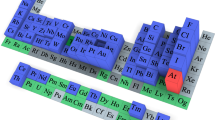Abstract
THE method of preparation of sources of some natural radio-elements (polonium, radium C, etc.) on metallic plates by electrochemical exchange and the advantages that it presents are well known. I have tried to apply the method to the separation of radio-copper (period 10 hr.) from zinc. Preliminary experiments have shown that, of the metals nickel, tin, lead and iron which are in the series of tension between copper and zinc, lead gives the best results. The following method has been adopted:
This is a preview of subscription content, access via your institution
Access options
Subscribe to this journal
Receive 51 print issues and online access
$199.00 per year
only $3.90 per issue
Buy this article
- Purchase on Springer Link
- Instant access to full article PDF
Prices may be subject to local taxes which are calculated during checkout
Similar content being viewed by others
Author information
Authors and Affiliations
Rights and permissions
About this article
Cite this article
HAÏSSINSKY, M. Deposition of Artificial Radio-Elements by Electro-chemical Exchange. Nature 136, 141–142 (1935). https://doi.org/10.1038/136141c0
Issue Date:
DOI: https://doi.org/10.1038/136141c0
Comments
By submitting a comment you agree to abide by our Terms and Community Guidelines. If you find something abusive or that does not comply with our terms or guidelines please flag it as inappropriate.



